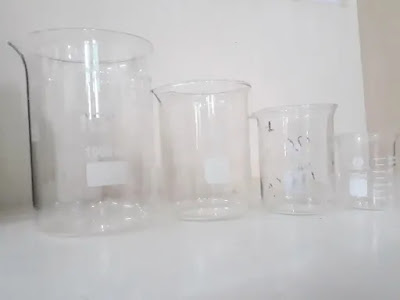“Uses of Beakers“
Contents
hide

Beakers are a crucial piece of laboratory apparatus that are engaged in a wide range of scientific processes & studies. They have a cylindrical shape, a flat bottom, and a pouring spout. They are manufactured of glass or plastic.
2. Beakers can also be used to make liquids boil more quickly or to simmer liquids more gently:
Beakers are frequently used for mixing and measuring liquids. Chemicals are frequently held and mixed in beakers during chemistry experiments. They can also be used to store solutions that are being shaken as well as hot or cooled liquids. like; Boiling water for some purpose.
3. Beakers used to measure solids:
Solid substances, like powders or pellets, can also be kept & measured in beakers. They can be employed to measure out a specified quantity of a chemical before being transferred to another container for additional use.
To measure out exact amounts of solid ingredients, use lab beakers. For instance, a lab beaker is able to precisely measure 100 milliliters of salt for an experiment. The salt can be combined with other substances, such as glucose or sodium bicarbonate, in the beaker.
4. Some things to consider when using Beakers in a chemical reaction:
Beakers can also be used as vessels for chemical reactions. They work well for mixing, heating, cooling, & even watching chemical reactions take place since the beaker’s flat bottom provides stability & its transparency makes it simple to view the reaction in progress.
1. Before using, make sure the beaker is clean & clear of impurities.
2. Use the proper-sized beaker for the reaction; using the improper beaker can result in hazardous spills.
3. When handling hot beakers, put on protective eyewear & other safety gear.
4. Overfilling the beaker should be avoided because it can lead to spillage & contaminants.
5. Use a stirring rod composed of a material that won’t clash with the contents in the beaker when blending or stirring.
6. Make that the reaction’s temperature is at a safe level by measuring it with a thermometer.
7. Assure your beaker gets vented to let the gas exit if the reaction creates a gas.
8. After using, safely dispose of the beaker & any chemicals still within.

5. Some current ideas to use Beakers in education settings:
Beakers are frequently employed in learning environments to instruct individuals on various scientific ideas. Both basic ideas like volume & measurement along with more complicated ideas like chemical reactions can be illustrated using them.
Below are some ideas that should be considered while using beakers for educational settings:
1. To illustrate the idea of displacement with various water volumes, use beakers.
2. To demonstrate how to measure precisely, utilize beakers to measure exactly various amounts of liquid.
3. Beakers can be used to instruct students on the value of precision in the lab.
4. Beakers can be used to demonstrate the density & viscosity of various liquids.
5. Beakers can be used to demonstrate how to combine various chemicals in a laboratory setting.
6. Beakers can be used to instruct students on the significance of lab safety.
7. Teach kids how to carry out experiments in a lab setting using beakers.
8. Beakers can be used to demonstrate the results of mixing various substances with liquids.
9. Teach learners about boiling & condensation using beakers.
6. Mentioning some fun ways to use Beakers:
Beakers can be used for tasks that are entertaining & artistic in addition to their practical applications. For instance, you could fill a beaker with some oil, water, & food colouring to make a handmade lava lamp. Alternately, you may use a beaker to produce homemade ice cream by combining cream, glucose, & vanilla extract in one, then set it in a larger container with a mixture of ice and salt.
Make a mobile, a light-up beaker, a mini-aquarium, a science-themed display, a candle holder out of a beaker, a beaker-painting party, a beaker-themed scavenger hunt, or beautify beakers with washi tape, stickers, or paint. One can also use beakers as paint containers for art projects.

7. Conclusion:
Beakers are crucial pieces of lab gear utilized for a range of tasks, tests, & procedures. They are inexpensive, adaptable, & enjoyable to use.



